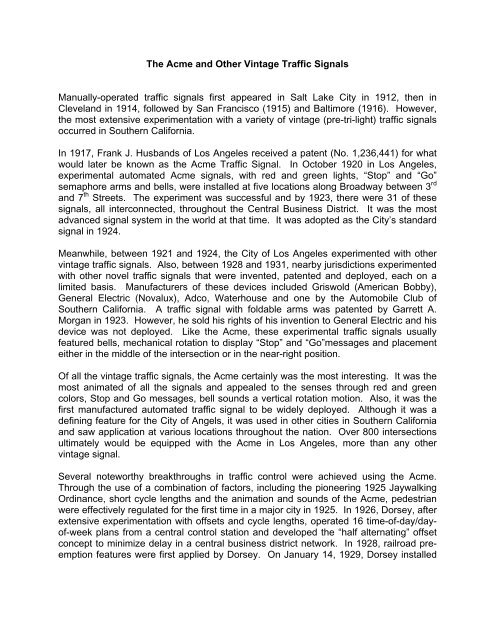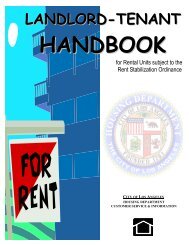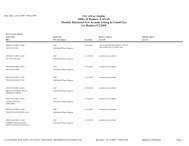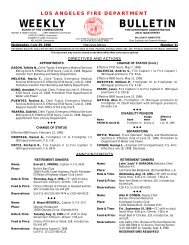The Acme and Other Vintage Traffic Signals - City of Los Angeles
The Acme and Other Vintage Traffic Signals - City of Los Angeles
The Acme and Other Vintage Traffic Signals - City of Los Angeles
Create successful ePaper yourself
Turn your PDF publications into a flip-book with our unique Google optimized e-Paper software.
<strong>The</strong> <strong>Acme</strong> <strong>and</strong> <strong>Other</strong> <strong>Vintage</strong> <strong>Traffic</strong> <strong>Signals</strong><br />
Manually-operated traffic signals first appeared in Salt Lake <strong>City</strong> in 1912, then in<br />
Clevel<strong>and</strong> in 1914, followed by San Francisco (1915) <strong>and</strong> Baltimore (1916). However,<br />
the most extensive experimentation with a variety <strong>of</strong> vintage (pre-tri-light) traffic signals<br />
occurred in Southern California.<br />
In 1917, Frank J. Husb<strong>and</strong>s <strong>of</strong> <strong>Los</strong> <strong>Angeles</strong> received a patent (No. 1,236,441) for what<br />
would later be known as the <strong>Acme</strong> <strong>Traffic</strong> Signal. In October 1920 in <strong>Los</strong> <strong>Angeles</strong>,<br />
experimental automated <strong>Acme</strong> signals, with red <strong>and</strong> green lights, “Stop” <strong>and</strong> “Go”<br />
semaphore arms <strong>and</strong> bells, were installed at five locations along Broadway between 3 rd<br />
<strong>and</strong> 7 th Streets. <strong>The</strong> experiment was successful <strong>and</strong> by 1923, there were 31 <strong>of</strong> these<br />
signals, all interconnected, throughout the Central Business District. It was the most<br />
advanced signal system in the world at that time. It was adopted as the <strong>City</strong>’s st<strong>and</strong>ard<br />
signal in 1924.<br />
Meanwhile, between 1921 <strong>and</strong> 1924, the <strong>City</strong> <strong>of</strong> <strong>Los</strong> <strong>Angeles</strong> experimented with other<br />
vintage traffic signals. Also, between 1928 <strong>and</strong> 1931, nearby jurisdictions experimented<br />
with other novel traffic signals that were invented, patented <strong>and</strong> deployed, each on a<br />
limited basis. Manufacturers <strong>of</strong> these devices included Griswold (American Bobby),<br />
General Electric (Novalux), Adco, Waterhouse <strong>and</strong> one by the Automobile Club <strong>of</strong><br />
Southern California. A traffic signal with foldable arms was patented by Garrett A.<br />
Morgan in 1923. However, he sold his rights <strong>of</strong> his invention to General Electric <strong>and</strong> his<br />
device was not deployed. Like the <strong>Acme</strong>, these experimental traffic signals usually<br />
featured bells, mechanical rotation to display “Stop” <strong>and</strong> “Go”messages <strong>and</strong> placement<br />
either in the middle <strong>of</strong> the intersection or in the near-right position.<br />
Of all the vintage traffic signals, the <strong>Acme</strong> certainly was the most interesting. It was the<br />
most animated <strong>of</strong> all the signals <strong>and</strong> appealed to the senses through red <strong>and</strong> green<br />
colors, Stop <strong>and</strong> Go messages, bell sounds a vertical rotation motion. Also, it was the<br />
first manufactured automated traffic signal to be widely deployed. Although it was a<br />
defining feature for the <strong>City</strong> <strong>of</strong> Angels, it was used in other cities in Southern California<br />
<strong>and</strong> saw application at various locations throughout the nation. Over 800 intersections<br />
ultimately would be equipped with the <strong>Acme</strong> in <strong>Los</strong> <strong>Angeles</strong>, more than any other<br />
vintage signal.<br />
Several noteworthy breakthroughs in traffic control were achieved using the <strong>Acme</strong>.<br />
Through the use <strong>of</strong> a combination <strong>of</strong> factors, including the pioneering 1925 Jaywalking<br />
Ordinance, short cycle lengths <strong>and</strong> the animation <strong>and</strong> sounds <strong>of</strong> the <strong>Acme</strong>, pedestrian<br />
were effectively regulated for the first time in a major city in 1925. In 1926, Dorsey, after<br />
extensive experimentation with <strong>of</strong>fsets <strong>and</strong> cycle lengths, operated 16 time-<strong>of</strong>-day/day<strong>of</strong>-week<br />
plans from a central control station <strong>and</strong> developed the “half alternating” <strong>of</strong>fset<br />
concept to minimize delay in a central business district network. In 1928, railroad preemption<br />
features were first applied by Dorsey. On January 14, 1929, Dorsey installed
the world first pedestrian activated (push button) signal as a school safety measure at<br />
the intersection <strong>of</strong> Figueroa Street <strong>and</strong> Meridian Avenue.<br />
But the honeymoon period for the <strong>Acme</strong> wouldn’t last forever. In October 1920, William<br />
Potts <strong>of</strong> Detroit invented <strong>and</strong> installed the first tri-light traffic signal. In 1922, a<br />
manufactured version <strong>of</strong> the tri-light signal was installed in Syracuse, New York. By the<br />
latter half <strong>of</strong> the 1920s, major cities that had been relying on traffic <strong>of</strong>ficers, signal<br />
towers <strong>and</strong> manual traffic signals decided to deploy automated traffic signals. By this<br />
time, several manufactured tri-light signals became available <strong>and</strong> worked well. At the<br />
same time, there was a backlash against the noisy bell sounds as the <strong>Acme</strong> began to<br />
be installed beyond the central business district near residential areas. In addition, the<br />
constant mechanical motion <strong>of</strong> the semaphore arms eventually resulted in their being<br />
stuck <strong>and</strong> out <strong>of</strong> sync with the bells <strong>and</strong> lights. (<strong>The</strong> lack <strong>of</strong> an explicit clearance interval<br />
wasn’t a large concern, as seven second all-red intervals were provided.) <strong>The</strong><br />
newspaper <strong>and</strong> civic leaders took notice <strong>of</strong> the tri-light signals in other large cities <strong>and</strong><br />
began a campaign to replace the <strong>Acme</strong>s. Miller McClintock was hired to prepare a<br />
traffic control plan for fashionable Wilshire Boulevard <strong>and</strong>, to no one’s surprise,<br />
recommended tri-light signals. Decorative Eagle signals replaced the <strong>Acme</strong>s on<br />
Wilshire Boulevard in September 1931, <strong>and</strong> no other <strong>Acme</strong>s were installed in the <strong>City</strong><br />
after that time. <strong>The</strong> <strong>Acme</strong> survived until December 1956, when the last one was<br />
removed.<br />
But the <strong>Acme</strong> lives on! One surviving <strong>and</strong> operable <strong>Acme</strong> is retained by the Department<br />
<strong>of</strong> Transportation. Another is on display at the Smithsonian in Washington, D.C. Three<br />
<strong>Acme</strong>s are located at the Orange Empire Trolley Museum in Perris, California, <strong>and</strong> a<br />
few are held by collectors. Period movies use replicated <strong>Acme</strong> signals to represent <strong>Los</strong><br />
<strong>Angeles</strong> in the 1930s <strong>and</strong> 1940s, such as “Who Framed Roger Rabbit” <strong>and</strong> “Devil in a<br />
Blue Dress”. Finally, the MGM/Disney <strong>The</strong>me Park in Orl<strong>and</strong>o, Florida immortalizes the<br />
Hollywood <strong>and</strong> Wilshire Districts by replicating nostalgic scenes <strong>and</strong> art deco buildings<br />
from the 1930s. At the intersections in this miniature city setting, they included <strong>Acme</strong><br />
traffic signals to put the finishing touches on the theme.<br />
C:\Documents <strong>and</strong> Settings\JANET E\My Documents\Historical\Trans Topics & Tales (in Word docs)\<strong>Acme</strong> <strong>and</strong> <strong>Other</strong> <strong>Vintage</strong> <strong>Traffic</strong> <strong>Signals</strong>.doc
<strong>The</strong> original <strong>Acme</strong> signal contract for the <strong>City</strong> <strong>of</strong> <strong>Los</strong><br />
<strong>Angeles</strong><br />
Graphic - 3138<br />
<strong>The</strong> second <strong>Acme</strong> signal style, circa 1926, on Wilshire<br />
Boulevard at Western Avenue<br />
Graphic - 1021<br />
<strong>The</strong> first <strong>Acme</strong> signal style, circa 1924<br />
Graphic - 1026<br />
<strong>The</strong> primary <strong>Acme</strong> style, circa 1928<br />
Graphic - 2042
<strong>Acme</strong> signal plan<br />
Graphic - 1049<br />
Ceremony for removal <strong>of</strong> the last <strong>Acme</strong> signal on Main<br />
Street at Sunset Boulevard, December 1956<br />
Graphic - 1038<br />
<strong>Acme</strong> signal bells<br />
Graphic - 3141<br />
<strong>Acme</strong> timing chart<br />
Graphic - 1024
<strong>Acme</strong> cartoon, illustrating signal birds<br />
Graphic - 3065<br />
Anti-<strong>Acme</strong> editorial cartoon<br />
Graphic - 3067<br />
Anti-<strong>Acme</strong> editorial cartoon<br />
Graphic - 3064<br />
Anti-<strong>Acme</strong> editorial cartoon<br />
Graphic - 3066
Anti-<strong>Acme</strong> editorial cartoon<br />
Graphic - 1031<br />
“Waterhouse”, the vintage signal <strong>of</strong> the<br />
County <strong>of</strong> <strong>Los</strong> <strong>Angeles</strong> on Santa Monica<br />
Boulevard at La Brea Avenue<br />
Graphic - 1025<br />
“American Bobby” signal at Wilshire Boulevard <strong>and</strong><br />
Western Avenue, looking north, circa 1925<br />
Graphic - 1032<br />
Adco signal on Washington Boulevard at MGM<br />
Studios<br />
Graphic - 3084
Auto Club signal at Adams Boulevard <strong>and</strong> Figueroa Street<br />
Graphic - 8042









